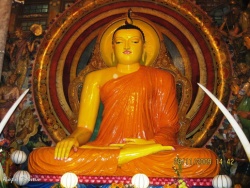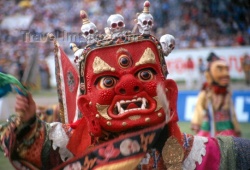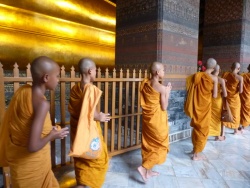Chandrakirti (Skt)
Chandrakirti (Skt)
月称 (c. 600–650) ( Jpn Gessho)
(1) A scholar of the Madhyamika school in India. In the early sixth century, Buddhapalita and Bhavaviveka wrote commentaries on Nagarjuna's Verses on the Middle Way (Skt Madhyamaka-karika ). The differences in their approach and explanation of the truth of nonsubstantiality resulted in the division of the Madhyamika school into the Prasangika school led by Buddhapalita and the Svatantrika school led by Bhavaviveka. Chandrakirti inherited the doctrine of Buddhapalita and criticized the doctrine of Bhavaviveka, thus completing the doctrine of the Prasangika school. For this reason, he is regarded as the effective founder of the Prasangika school. He asserted that the truth of nonsubstantiality is beyond the reach of logical demonstration and is attainable only by practice. The most important of his works is the Prasannapada (The Clear Worded), which is the only extant Sanskrit commentary on Verses on the Middle Way. Knowledge of the original Sanskrit text of Madhyamaka-karika is available only through the Prasannapada, the translation and study of which have therefore been carried out with great care and interest. Chandrakirti also wrote commentaries on Nagarjuna's other works and on Aryadeva's Four-Hundred-Verse Treatise. His original work is Entering the Middle Way (Madhyamakavatara). These works are extant in their Tibetan translations.
Chandrakirti was born in India. The descriptions as his family-background vary slightly depending on the different historians. According to the history given by Marpa, Chandrakirti was born in a town called Serna (the Tibetan term of that town in India at that time).
According to Marpa he was born in a royal family; other sources say that Chandrakirti was born in a Brahmin family. In any case, the family Chandrakirti was born in was a Buddhist family, which meant that from childhood onwards he was in contact with such teachings and his tendencies of bodhicitta from previous lifetimes awakened very early.
This brought about his wish to lead the life of a Buddhist monk. He took monastic ordination in his youth and studied intensively the various Buddhist treatises. In particular he had access to the entire variety of teachings given by the great master Nagarjuna. In some sources it is explained that he studied Nagarjuna?s texts with a teacher called Chandrapala; some other sources, however, say that Chandrakirti in fact was a direct student of Nagarjuna himself, studied with Nagarjuna in the later part of Nagarjuna?s life. In any case he had complete access to all the teachings given by Nagarjuna and was able to comprehend them. Having studied all of them he put them into practice and it is said that Chandrakirti - through putting these teachings into practice - achieved the 6th bodhisattva bhumi. He was hence a great realized bodhisattva.
Chandrakirti was a great master who had direct realization of the true nature of reality, of emptiness. This is also obvious from the following part of his life. Chandrakirti spent many years in Nalanda. Nalanda was one of the most important Buddhist monastic colleges of India at that time. For a period of twelve years Chandrakirti supplied all the monks living there with food, with milk and yoghurt. His job during this period of time was taking care of the cows that belonged to the monastery, cows from which they used to get these supplies. During these twelve years Chandrakirti simply went out with these cows and let them be on their own somewhere in the forest. But nevertheless on his return there was abundance of supply, of milk and milk products. The point of this story is that Chandrakirti actually during this time had painted a picture of a cow. He obtained the milk by milking the picture and not the cows. They where left on there own. This story shows that to someone who has direct realization of reality there is in fact no difference whether you milk a real cow or a picture of a cow. It does not make a difference at all as the clinging to things to be real is overcome. This account of Chandrakirti?s life shows his great realization, and one should be aware of the fact that for a period of twelve years he supplied the monastery with food in this way.
While Chandrakirti lived in Nalanda he was one of the most important Panditas that is to say Buddhist Masters at that place. It was a custom in India that such type of monastic colleges would be challenged by scholars from other traditions, non-Buddhist traditions, who would come to that place and be received at the gate of the respective college, in this case Nalanda. At the gate would be a scholar of the institute whose responsibility it was to respond to the philosophical questions raised by the challengers. Chandrakirti did that a lot to that extent that he led debate with 50 to 60 people per day. So, 50 or 60 people came to this monastery in order to debate on religious issues.
Chandrakirti?s activity was to win these debates from the Buddhist perspective. That is why he became so important for the institute and finally became the abbot of Nalanda. Furthermore, one should know that Chandrakirti is said to have attained realization through the practice of the Guhyasamaja Tantra. He is in fact one of the most important lineage holders of this particular Tantra. It is said that Chandrakirti through his great realization was able to live for a period of 300 years, in other words he was able to prolong his lifespan. In fact he had attained the accomplishment of deathlessness, of immortality, which means that even though he does no more life in his previous physical body, he in fact never died. There are a number of accounts: It is recounted that Buddhist Masters in Tibet for example were in direct contact with Chandrakirti, met Chandrakirti in his wisdom-body and received teachings from him.
At that time India had very fruitful traditions in the way different religious schools were in contact with each other. It was not that one religious tradition would fight the other one in order to destroy it etc. This was not at all the case. There was a culture of philosophical or religious discussions and the point was that if such a debate took place the one who was able to proof his points/ his views in the most accurate way by means of logic and reasoning of course was the winner of that debate. The loser, the one whose arguments, whose points were not as accurate and precise, would then either resign or would actually adopt the religious tradition of the partner of discussion. This was a very fruitful situation in India. That also makes clear how important these people were in such colleges whose responsibility it was to face the challenges by other religious traditions, to lead such debates. While Chandrakirti was acting as such a representative of Buddhist views there were many Hindu-Scholars or masters who therefore started to practice Buddhism.
It was not only the case that different religions or representatives of them would lead such debates; such debates were also very common within Buddhist schools. There were different philosophical schools in Buddhism. For a certain period of time, for example, one master called Chandragomin came to Nalanda who spoke on behalf of the Cittamatra school of thought, which is the tradition founded mainly by the great master Asanga. The views maintained in this tradition differ slightly from the Madhyamaka school of thought, whose founding father was Nagarjuna. What happened at that time was that Chandrakirti and Chandragomin engaged in a debate were Chandrakirti made clear the views of the Madhyamaka school of thought and Chandragomin presented the Cittamatra views. This debate took seven years and it was a public event. People joined in and listened and it is said that as people listened to the explanations of the Madhyamaka?s and Cittamatra?s point of view in such detail again and again, they actually became able to understand what the Madhyamaka view and the Cittamatra view are like. The people in the surrounding villages used to come and attend these debates and therefore were actually able to understand the Buddhist views.
(2)月称大臣( Jpn Gassho-daijin): Also known as Chandrayashas. A minister who served Ajatashatru, the king of Magadha in India. He is mentioned in theNirvana Sutra. The king was suffering from virulent sores all over his body because of his offense of killing his father, Bimbisara, a patron of Shakyamuni Buddha. His six ministers appeared in succession before him, each exhorting him to consult a different one of the six non-Buddhist teachers for a remedy. Chandrakirti was the first of these ministers to address the king. He urged Ajatashatru to see Purana, the non-Buddhist teacher known for his denial that there is a causal relationship between one's deeds and what one experiences as a result.
See also; six minister.


